suspension Peugeot 508 2020 Owner's Manual
[x] Cancel search | Manufacturer: PEUGEOT, Model Year: 2020, Model line: 508, Model: Peugeot 508 2020Pages: 276, PDF Size: 8.43 MB
Page 4 of 276

2
Contents
■
Overview
■
Eco-driving
1Instruments
Digital instrument panels 9
Warning and indicator lamps 11
Indicators 16
Manual test 20
Total distance recorder 20
Lighting dimmer 20
Trip computer 21
Touch screen 22
Remote features (Hybrid) 24
2Access
Electronic key with remote control function and
built-in key, 25
Keyless Entry and Starting 27
Back-up procedures 29
Central locking 30
Alarm 31
Doors 33
Boot 34
Hands-free tailgate 34
Electric windows 38
Panoramic sunroof 39
3Ease of use and comfort
Driving position 41
Front seats 42
Steering wheel adjustment 45
Mirrors 45
Rear seats 46
Heating and Ventilation 48
Dual-zone automatic air conditioning 49
Front demisting - defrosting 52
Heated windscreen 52
Rear screen demisting/defrosting 52
Additional heating/ventilation system 53
Thermal pre-conditioning (Hybrid) 54
Front fittings 55
Courtesy lamps 58
Interior ambient lighting 59
Rear fittings 59
Boot fittings 60
4Lighting and visibility
Exterior lighting control stalk 65
Direction indicators 66
Headlamp beam height adjustment 67
Automatic illumination of headlamps 67
Guide-me-home and welcome lighting 67
Automatic headlamp dipping 68
Static cornering lighting 69
Night Vision 69
Wiper control stalk 71
Changing a wiper blade 73
Automatic wipers 73
5Safety
General safety recommendations 75
Hazard warning lamps 75
Horn 76
Pedestrian horn
(Hybrid) 76
Emergency or assistance call 76
Electronic stability control (ESC) 78
Seat belts 80
Airbags 81
Active bonnet 84
Child seats 85
Deactivating the front passenger airbag 87
ISOFIX child seats 89
i-Size child seats 93
Child lock 94
6Driving
Driving recommendations 96
Starting/Switching off the engine 97
Starting hybrid vehicles 98
Electric parking brake 99
Manual gearbox 102
Automatic gearbox 102
Electric automatic gearbox (Hybrid) 105
Hill start assist 106
Active Suspension Control 107
Driving modes 107
Gear efficiency indicator 108
Stop & Start 109
Under-inflation detection 11 0
Driving and manoeuvring aids - General
recommendations
11 2
Speed Limit Recognition and
Recommendation
11 3
Speed limiter 11 6
Programmable cruise control 11 9
Memorising speeds 120
Drive Assist Plus 121
Adaptive Cruise Control 121
Active Lane Keeping Assist 125
Page 77 of 276
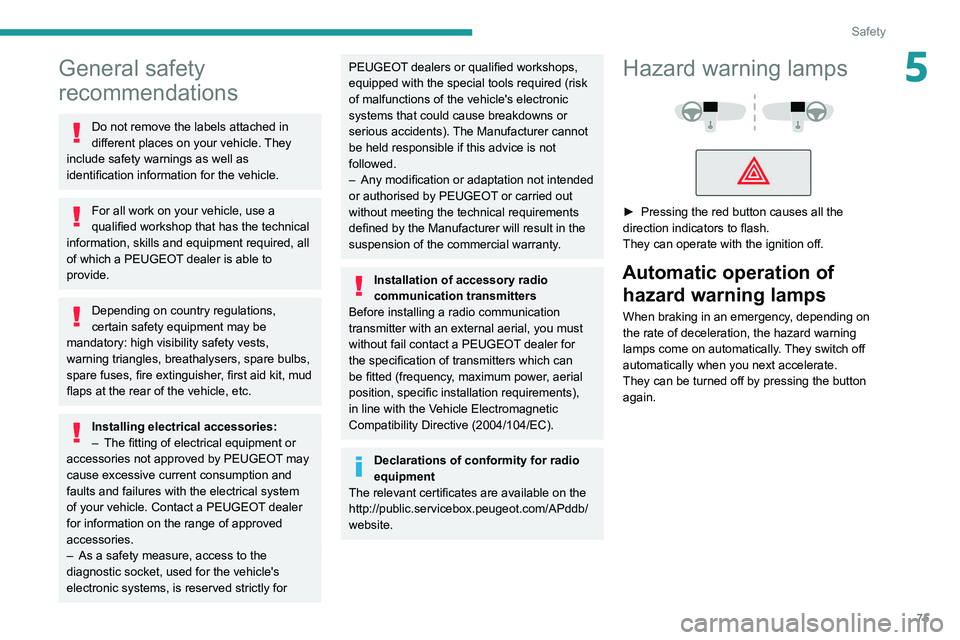
75
Safety
5General safety
recommendations
Do not remove the labels attached in
different places on your vehicle. They
include safety warnings as well as
identification information for the vehicle.
For all work on your vehicle, use a
qualified workshop that has the technical
information, skills and equipment required, all
of which a PEUGEOT dealer is able to
provide.
Depending on country regulations,
certain safety equipment may be
mandatory: high visibility safety vests,
warning triangles, breathalysers, spare bulbs,
spare fuses, fire extinguisher, first aid kit, mud
flaps at the rear of the vehicle, etc.
Installing electrical accessories:
– The fitting of electrical equipment or
accessories not approved by PEUGEOT
may
cause excessive current consumption and
faults and failures with the electrical system
of your vehicle. Contact a PEUGEOT dealer
for information on the range of approved
accessories.
–
As a safety measure, access to the
diagnostic socket, used for the vehicle's
electronic systems, is reserved strictly for
PEUGEOT dealers or qualified workshops,
equipped with the special tools required (risk
of malfunctions of the vehicle's electronic
systems that could cause breakdowns or
serious accidents). The Manufacturer cannot
be held responsible if this advice is not
followed.
–
Any modification or adaptation not intended
or authorised by PEUGEOT
or carried out
without meeting the technical requirements
defined by the Manufacturer will result in the
suspension of the commercial warranty.
Installation of accessory radio
communication transmitters
Before installing a radio communication
transmitter with an external aerial, you must
without fail contact a PEUGEOT dealer for
the specification of transmitters which can
be fitted (frequency, maximum power, aerial
position, specific installation requirements),
in line with the Vehicle Electromagnetic
Compatibility Directive (2004/104/EC).
Declarations of conformity for radio
equipment
The relevant certificates are available on the
http://public.servicebox.peugeot.com/APddb/
website.
Hazard warning lamps
► Pressing the red button causes all the
direction indicators to flash.
They can operate with the ignition off.
Automatic operation of hazard warning lamps
When braking in an emergency, depending on
the rate of deceleration, the hazard warning
lamps come on automatically. They switch off
automatically when you next accelerate.
They can be turned off by pressing the button
again.
Page 109 of 276
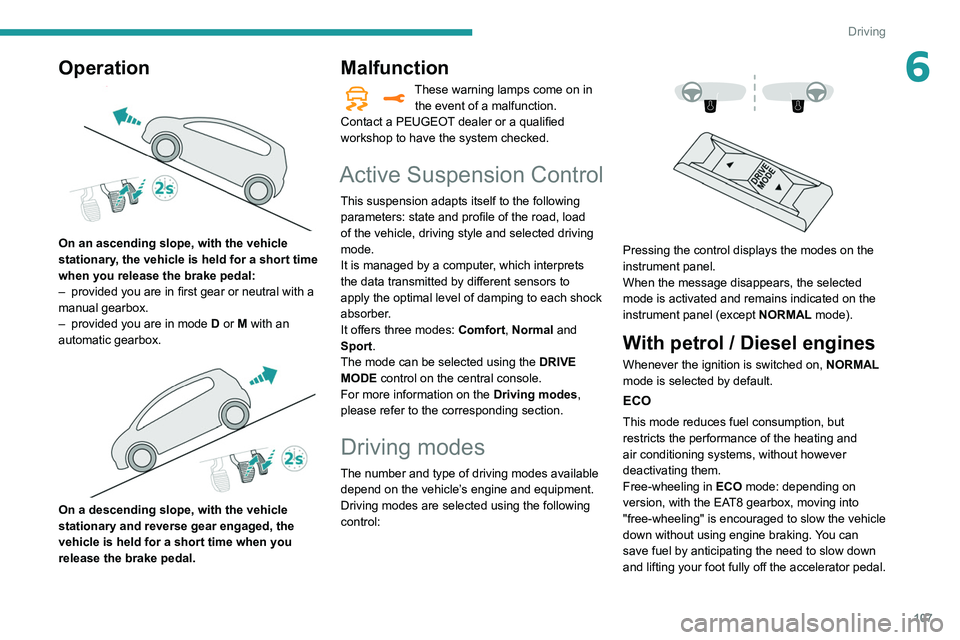
107
Driving
6Operation
On an ascending slope, with the vehicle
stationary, the vehicle is held for a short time
when you release the brake pedal:
–
provided you are in first gear or neutral with a
manual gearbox.
–
provided you are in mode D
or M with an
automatic gearbox.
On a descending slope, with the vehicle
stationary and reverse gear engaged, the
vehicle is held for a short time when you
release the brake pedal.
Malfunction
These warning lamps come on in the event of a malfunction.
Contact a PEUGEOT dealer or a qualified
workshop to have the system checked.
Active Suspension Control
This suspension adapts itself to the following
parameters: state and profile of the road, load
of the vehicle, driving style and selected driving
mode.
It is managed by a computer, which interprets
the data transmitted by different sensors to
apply the optimal level of damping to each shock
absorber.
It offers three modes: Comfort, Normal and
Sport.
The mode can be selected using the DRIVE
MODE control on the central console.
For more information on the Driving modes,
please refer to the corresponding section.
Driving modes
The number and type of driving modes available depend on the vehicle’s engine and equipment.
Driving modes are selected using the following
control:
Pressing the control displays the modes on the
instrument panel.
When the message disappears, the selected
mode is activated and remains indicated on the
instrument panel (except NORMAL mode).
With petrol / Diesel engines
Whenever the ignition is switched on, NORMAL
mode is selected by default.
ECO
This mode reduces fuel consumption, but
restricts the performance of the heating and
air conditioning systems, without however
deactivating them.
Free-wheeling in ECO mode: depending on
version, with the EAT8 gearbox, moving into
"free-wheeling" is encouraged to slow the vehicle
down without using engine braking. You can
save fuel by anticipating the need to slow down
and lifting your foot fully off the accelerator pedal.
Page 110 of 276
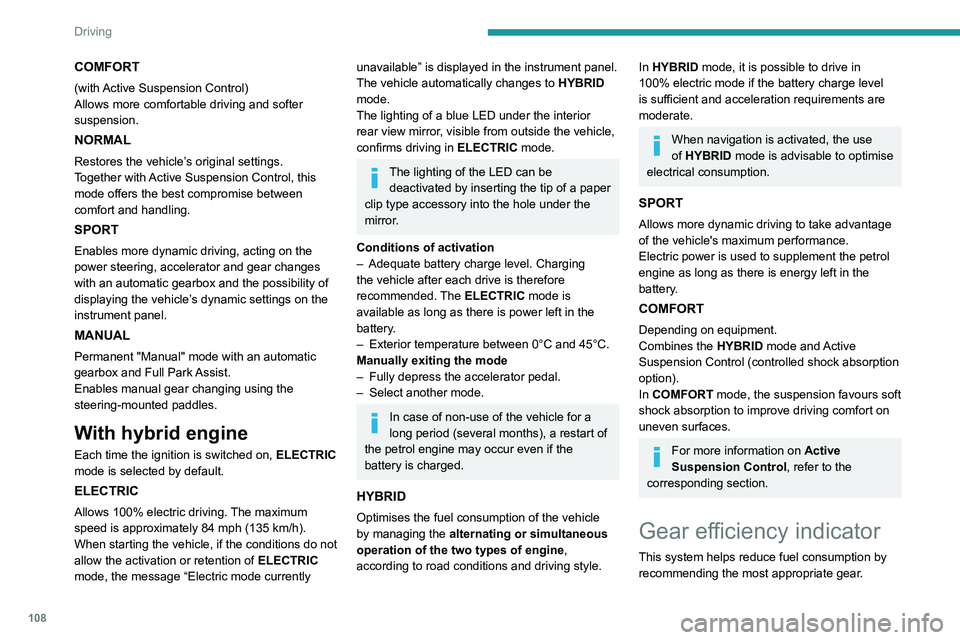
108
Driving
COMFORT
(with Active Suspension Control)
Allows more comfortable driving and softer
suspension.
NORMAL
Restores the vehicle’s original settings.
Together with Active Suspension Control, this
mode offers the best compromise between
comfort and handling.
SPORT
Enables more dynamic driving, acting on the
power steering, accelerator and gear changes
with an automatic gearbox and the possibility of
displaying the vehicle’s dynamic settings on the
instrument panel.
MANUAL
Permanent "Manual" mode with an automatic
gearbox and Full Park Assist.
Enables manual gear changing using the
steering-mounted paddles.
With hybrid engine
Each time the ignition is switched on, ELECTRIC
mode is selected by default.
ELECTRIC
Allows 100% electric driving. The maximum
speed is approximately 84 mph (135 km/h).
When starting the vehicle, if the conditions do not
allow the activation or retention of
ELECTRIC
mode, the message
“Electric mode currently
unavailable” is displayed in the instrument panel.
The vehicle automatically changes to HYBRID
mode.
The lighting of a blue LED under the interior
rear view mirror, visible from outside the vehicle,
confirms driving in ELECTRIC mode.
The lighting of the LED can be
deactivated by inserting the tip of a paper
clip type accessory into the hole under the
mirror
.
Conditions of activation
–
Adequate battery charge level. Charging
the vehicle after each drive is therefore
recommended.
The ELECTRIC mode is
available as long as there is power left in the
battery.
–
Exterior temperature between 0°C and 45°C.
Manually exiting the mode
–
Fully depress the accelerator pedal.
–
Select another mode.
In case of non-use of the vehicle for a
long period (several months), a restart of
the petrol engine may occur even if the
battery is charged.
HYBRID
Optimises the fuel consumption of the vehicle
by managing the alternating or simultaneous
operation of the two types of engine ,
according to road conditions and driving style.
In HYBRID mode, it is possible to drive in
100% electric mode if the battery charge level
is sufficient and acceleration requirements are
moderate.
When navigation is activated, the use
of HYBRID mode is advisable to optimise
electrical consumption.
SPORT
Allows more dynamic driving to take advantage
of the vehicle's maximum performance.
Electric power is used to supplement the petrol
engine as long as there is energy left in the
battery.
COMFORT
Depending on equipment.
Combines the HYBRID mode and Active
Suspension Control (controlled shock absorption
option).
In COMFORT mode, the suspension favours soft
shock absorption to improve driving comfort on
uneven surfaces.
For more information on Active
Suspension Control , refer to the
corresponding section.
Gear efficiency indicator
This system helps reduce fuel consumption by
recommending the most appropriate gear.
Operation
Depending on the driving situation and the
vehicle's equipment, the system may advise
skipping one or more gears.
Gear engagement recommendations are only
optional. In fact, the configuration of the road,
the traffic density and safety remain determining
factors when choosing the best gear. Therefore,
the driver remains responsible for deciding
whether or not to follow the system’s advice.
This function cannot be deactivated.
With an automatic gearbox, the system is
only active in manual operation.
The information appears in the instrument panel in the form of an arrow and the
recommended gear.
The system adapts its gear shift recommendation according to the driving
conditions (slope, load, etc.) and the driver’s
requirements (power, acceleration, braking,
etc.).
The system never suggests:
– engaging first gear,
– engaging reverse.
Stop & Start
The Stop & Start function puts the engine
temporarily into standby - STOP mode - during
phases when the vehicle is stopped (red lights,
Page 128 of 276

126
Driving
control being paused will also cause the
system to be paused.
If the system detects that the driver is not
holding the wheel firmly enough, it
triggers a series of gradual alerts and then
deactivates itself if there is no response from
the driver.
If the function is suspended due to the
prolonged release of the force holding
the steering wheel, you must reactivate it by
pressing the button again.
Automatic pause
– Triggering of the ESC.
– Prolonged failure to detect one of the lane limit
markings. In this case, the active lane departure
warning function can take over
, and the system
will reactivate itself once the operating conditions
are again met.
In response to action by the driver:
suspension
– Activation of the direction indicators.
– T ravelling outside the lane limits.
–
T
oo tight a grip on the steering wheel or
dynamic action on the steering wheel.
–
Action on the brake pedal (resulting in a pause
until cruise control is reactivated) or accelerator
pedal (suspension for as long as the pedal is
depressed).
–
Pausing of the cruise control.
–
Deactivation of the
ASR.
Driving situations and related alerts
The tables below describe the displays associated with the main driving \
situations. The display of these alerts is not sequential.
Button indicator lamp Cruise control thumbwheelSymbols
Display Comments
Off CRUISE
(grey)
(grey)Cruise control paused; lane positioning
assist not active.
Off CRUISE
(green)
(grey)Cruise control active; lane
positioning
assist not active.
Green CRUISE
(green)
(green)Drive Assist Plus active, operates normally
(correction is executed at the steering
wheel).
Page 246 of 276
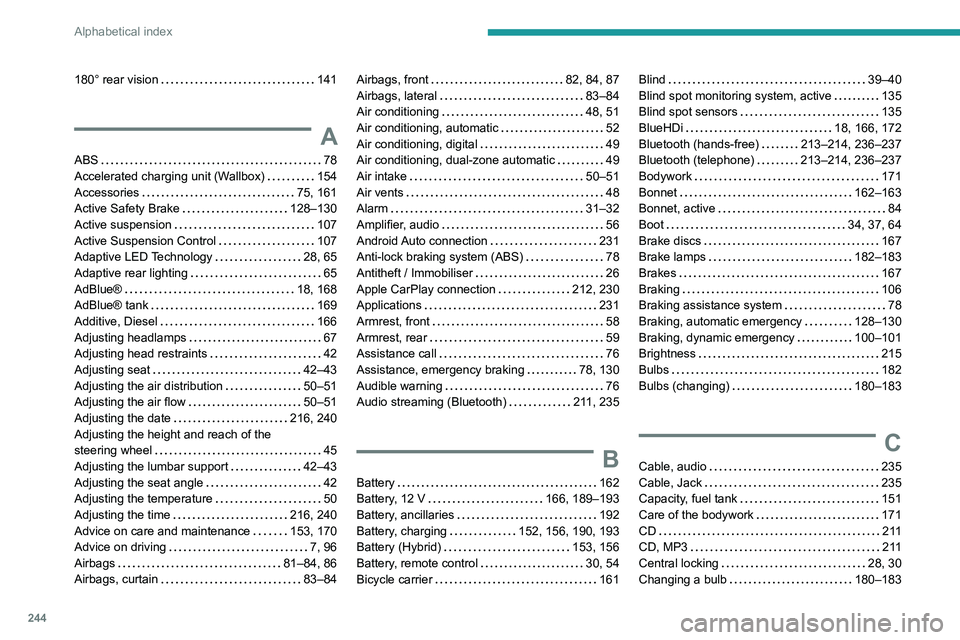
244
Alphabetical index
180° rear vision 141
A
ABS 78
Accelerated charging unit (Wallbox)
154
Accessories
75, 161
Active Safety Brake
128–130
Active suspension
107
Active Suspension Control
107
Adaptive LED Technology
28, 65
Adaptive rear lighting
65
AdBlue®
18, 168
AdBlue® tank
169
Additive, Diesel
166
Adjusting headlamps
67
Adjusting head restraints
42
Adjusting seat
42–43
Adjusting the air distribution
50–51
Adjusting the air flow
50–51
Adjusting the date
216, 240
Adjusting the height and reach of the
steering wheel
45
Adjusting the lumbar support
42–43
Adjusting the seat angle
42
Adjusting the temperature
50
Adjusting the time
216, 240
Advice on care and maintenance
153, 170
Advice on driving
7, 96
Airbags
81–84, 86
Airbags, curtain
83–84
Airbags, front 82, 84, 87
Airbags, lateral
83–84
Air conditioning
48, 51
Air conditioning, automatic
52
Air conditioning, digital
49
Air conditioning, dual-zone automatic
49
Air intake
50–51
Air vents
48
Alarm
31–32
Amplifier, audio
56
Android Auto connection
231
Anti-lock braking system (ABS)
78
Antitheft / Immobiliser
26
Apple CarPlay connection
212, 230
Applications
231
Armrest, front
58
Armrest, rear
59
Assistance call
76
Assistance, emergency braking
78, 130
Audible warning
76
Audio streaming (Bluetooth)
211, 235
B
Battery 162
Battery, 12 V
166, 189–193
Battery, ancillaries
192
Battery, charging
152, 156, 190, 193
Battery (Hybrid)
153, 156
Battery, remote control
30, 54
Bicycle carrier
161
Blind 39–40
Blind spot monitoring system, active
135
Blind spot sensors
135
BlueHDi
18, 166, 172
Bluetooth (hands-free)
213–214, 236–237
Bluetooth (telephone)
213–214, 236–237
Bodywork
171
Bonnet
162–163
Bonnet, active
84
Boot
34, 37, 64
Brake discs
167
Brake lamps
182–183
Brakes
167
Braking
106
Braking assistance system
78
Braking, automatic emergency
128–130
Braking, dynamic emergency
100–101
Brightness
215
Bulbs
182
Bulbs (changing)
180–183
C
Cable, audio 235
Cable, Jack
235
Capacity, fuel tank
151
Care of the bodywork
171
CD
2 11
CD, MP3
2 11
Central locking
28, 30
Changing a bulb
180–183
Page 251 of 276
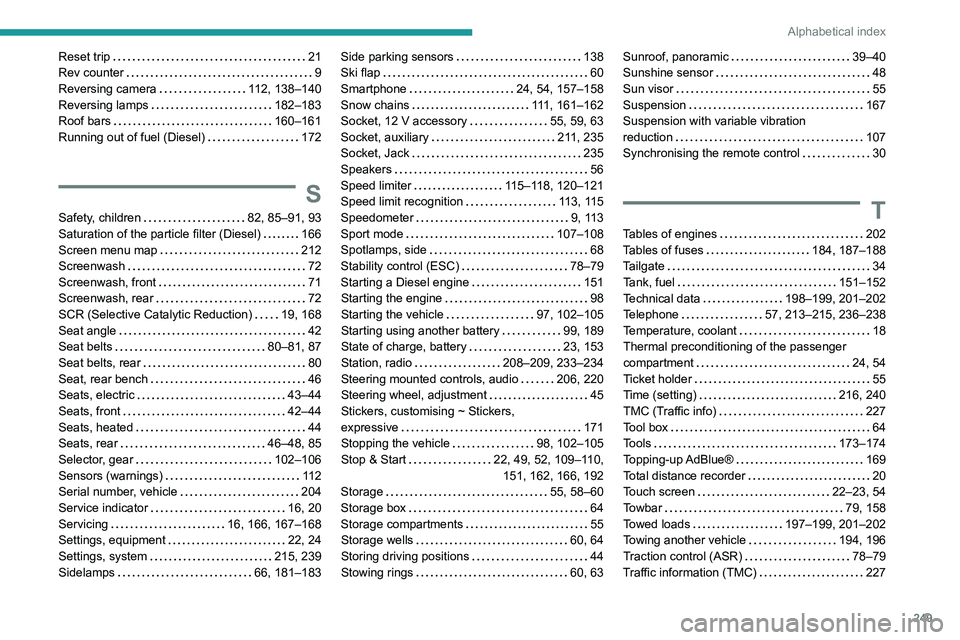
249
Alphabetical index
Reset trip 21
Rev counter
9
Reversing camera
112, 138–140
Reversing lamps
182–183
Roof bars
160–161
Running out of fuel (Diesel)
172
S
Safety, children 82, 85–91, 93
Saturation of the particle filter (Diesel)
166
Screen menu map
212
Screenwash
72
Screenwash, front
71
Screenwash, rear
72
SCR (Selective Catalytic Reduction)
19, 168
Seat angle
42
Seat belts
80–81, 87
Seat belts, rear
80
Seat, rear bench
46
Seats, electric
43–44
Seats, front
42–44
Seats, heated
44
Seats, rear
46–48, 85
Selector, gear
102–106
Sensors (warnings)
11 2
Serial number, vehicle
204
Service indicator
16, 20
Servicing
16, 166, 167–168
Settings, equipment
22, 24
Settings, system
215, 239
Sidelamps
66, 181–183
Side parking sensors 138
Ski flap
60
Smartphone
24, 54, 157–158
Snow chains
111, 161–162
Socket, 12 V accessory
55, 59, 63
Socket, auxiliary
211, 235
Socket, Jack
235
Speakers
56
Speed limiter
115–118, 120–121
Speed limit recognition
113, 115
Speedometer
9, 113
Sport mode
107–108
Spotlamps, side
68
Stability control (ESC)
78–79
Starting a Diesel engine
151
Starting the engine
98
Starting the vehicle
97, 102–105
Starting using another battery
99, 189
State of charge, battery
23, 153
Station, radio
208–209, 233–234
Steering mounted controls, audio
206, 220
Steering wheel, adjustment
45
Stickers, customising ~ Stickers,
expressive
171
Stopping the vehicle
98, 102–105
Stop & Start
22, 49, 52, 109–110,
151, 162, 166, 192
Storage
55, 58–60
Storage box
64
Storage compartments
55
Storage wells
60, 64
Storing driving positions
44
Stowing rings
60, 63Sunroof, panoramic 39–40
Sunshine sensor
48
Sun visor
55
Suspension
167
Suspension with variable vibration
reduction
107
Synchronising the remote control
30
T
Tables of engines 202
Tables of fuses
184, 187–188
Tailgate
34
Tank, fuel
151–152
Technical data
198–199, 201–202
Telephone
57, 213–215, 236–238
Temperature, coolant
18
Thermal preconditioning of the passenger
compartment
24, 54
Ticket holder
55
Time (setting)
216, 240
TMC (Traffic info)
227
Tool box
64
Tools
173–174
Topping-up AdBlue®
169
Total distance recorder
20
Touch screen
22–23, 54
Towbar
79, 158
Towed loads
197–199, 201–202
Towing another vehicle
194, 196
Traction control (ASR)
78–79
Traffic information (TMC)
227